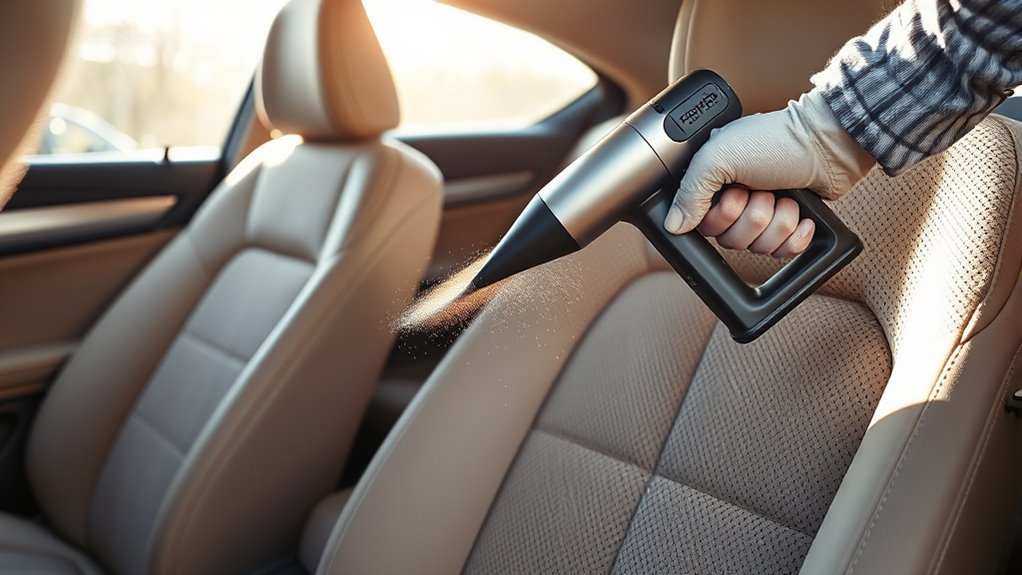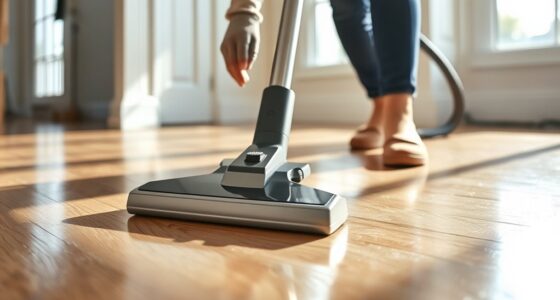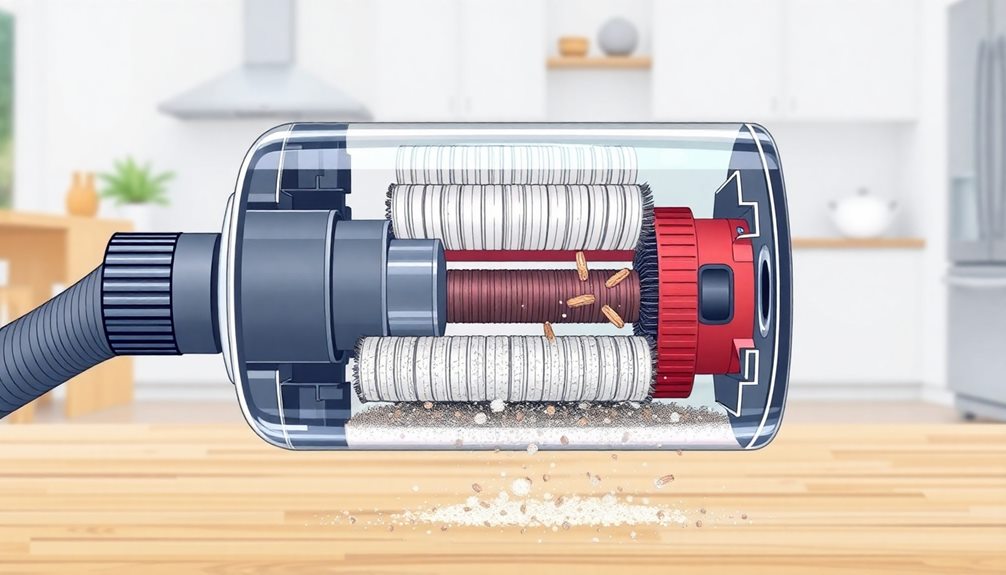To vacuum your car interior like a detailer without specialty gear, start by removing loose items and floor mats. Use your regular vacuum with crevice tools and soft brushes to clean seats, carpets, and hard-to-reach spots systematically. Focus on seams, vents, and under seats with gentle strokes, and sprinkle baking soda on carpets for odors. With a careful, organized approach, you’ll achieve a professional look—keep going to discover more tips for flawless results.
Key Takeaways
- Remove all loose items and debris to ensure thorough vacuuming of every surface.
- Use the vacuum’s attachments, like crevice tools and soft brushes, for tight spots and delicate areas.
- Vacuum systematically, starting with seats, then carpets, and interior panels, using overlapping strokes.
- Focus on high-traffic and hidden areas such as under seats, between cushions, and vents.
- Repeat vacuuming and incorporate gentle, controlled strokes to achieve professional results without specialized equipment.

Keeping your car interior clean starts with regular vacuuming, which effectively removes dirt, crumbs, and debris that accumulate over time. To achieve a thorough interior cleaning, you need to master vacuuming techniques that mimic professional detailers, even without specialized gear. The key is understanding how to use your vacuum cleaner efficiently and reach all those tricky spots in your vehicle.
Start by removing any loose items like trash, floor mats, and personal belongings. Once those are out of the way, you can focus on the vacuuming process. Use a vacuum with adjustable suction and various attachments, if available. If your vacuum has a crevice tool, it becomes your best friend for reaching tight corners and between seats. Attachments with soft brushes help lift dust from fabric surfaces without damaging the material.
Start by clearing loose items and using attachments like crevice tools and soft brushes for thorough vacuuming.
When vacuuming, work systematically, beginning with the seats. Use the crevice tool to clean in between the seat cushions and along the seams where dirt tends to settle. For fabric seats, vacuum in a gentle, overlapping motion, ensuring you lift dirt without pushing it further into the fibers. For leather or vinyl, a softer approach works best to avoid scratches. Don’t forget to vacuum the back of the seats and the seat rails, as these often collect dust and debris.
Next, move to the carpets and floor mats. Remove the mats and vacuum underneath them thoroughly. When vacuuming carpets, use slow, deliberate strokes to lift dirt from deep within the fibers. For heavily soiled areas, a quick sprinkle of baking soda before vacuuming can help neutralize odors and loosen grime. Pay close attention to the areas under the seats and around the pedals, as these spots tend to get the dirtiest.
Don’t neglect the interior panels, door sills, and dashboard edges. Use the crevice tool to clear out dust from tight gaps and vents. For larger panels, a soft brush attachment helps dislodge stubborn dirt, making vacuuming easier. Remember, effective interior cleaning isn’t just about superficial surface cleaning but about reaching into every nook and cranny. Incorporating proper vacuuming techniques can significantly improve your results and help maintain your vehicle’s longevity.
Finally, go over the entire interior one more time with your vacuum to pick up any remaining dust and debris. Regular vacuuming, combined with proper interior cleaning techniques, keeps your vehicle looking fresh and extends the life of your upholstery. With a little practice, you can vacuum your car like a pro—no special gear required—ensuring a clean, comfortable ride every time.
Frequently Asked Questions
Can I Vacuum Using Household Tools Effectively?
Yes, you can vacuum using household tools effectively. Grab a handheld attachment to reach tight spots and use upholstery brushes to loosen dirt on seats and carpets. Just guarantee your vacuum has enough suction power, and work slowly to lift debris thoroughly. With these basic tools, you’ll get a clean interior without needing specialty gear, making the job easier and more efficient for your car’s interior maintenance.
What Safety Precautions Should I Take During Vacuuming?
Think of vacuuming as a dance—you need to stay in step with safety. Always wear safety gear like masks and gloves to protect against dust and debris. Make certain proper ventilation by opening windows to keep fresh air flowing. Keep the vacuum cord out of your way to prevent trips. These precautions help you stay safe while keeping your car interior spotless, just like a professional detailer.
How Do I Remove Pet Hair From Car Seats?
To remove pet hair from car seats, start with a rubber glove or a pet hair removal brush to loosen and lift hair from upholstery. Use a vacuum with a brush attachment to suction away the hair effectively. For stubborn areas, lightly dampen a microfiber cloth to help gather remaining hair. Regular upholstery cleaning with these methods keeps your car looking fresh and free of pet hair.
Is It Necessary to Clean Under the Floor Mats?
Think of your car’s interior as a hidden treasure chest; cleaning under the floor mats reveals forgotten debris and dust. You should definitely remove mats periodically for thorough undercarriage cleaning, preventing dirt buildup and odor. Mat removal isn’t just about aesthetics—it’s about maintaining your car’s hygiene and longevity. Don’t overlook this step, as dirt trapped beneath can cause long-term damage, making regular under-mat cleaning essential for a fresh, clean interior.
How Often Should I Vacuum My Car Interior?
You should vacuum your car interior regularly to maintain cleanliness and prevent dirt buildup. Aim for weekly vacuum maintenance, especially if you frequently use your vehicle or have pets. This routine helps keep carpets and seats in good condition and simplifies interior detailing. Consistent vacuuming also prevents debris from settling deeply, making future cleaning easier. By sticking to a schedule, you’ll keep your car looking fresh and prolong its interior’s lifespan.
Conclusion
Think of vacuuming your car like tending a garden—you don’t need fancy tools to see the beauty blossom. When you tackle those hidden crumbs and dust, you’re restoring your vehicle’s comfort and value. I once thought only pros could do it well, but after a quick DIY session, I realized simple tools and a bit of effort make all the difference. With a little time, you can transform your car’s interior into a spotless sanctuary—no specialty gear required.









